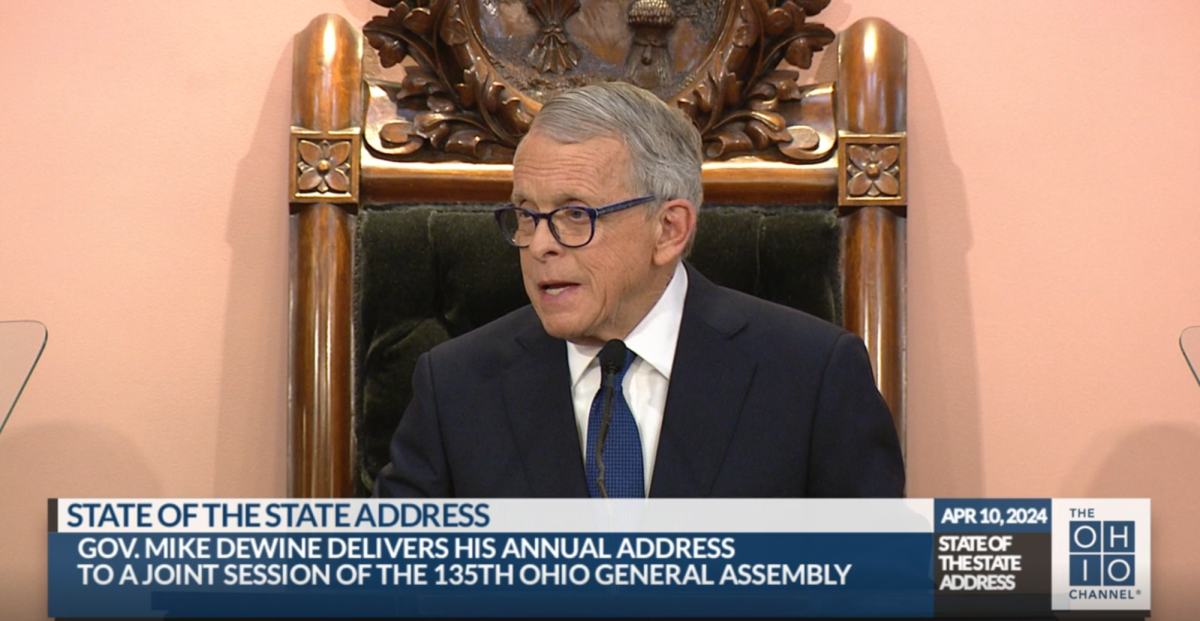Since Ohio’s founding as a state, the governor has addressed his fellow officeholders and the public at large in what has become to be known as the State of the State address.
This yearly public speech, often in January, before a joint session of the Ohio Legislature, allows the governor to discuss his goals for the year and how his administration seeks to accomplish them.
Like the State of the Union, given by the president of the United States, the event is one of the few times each year that most statewide elected officials and members of the legislature are in one room together. In recent years, the speech has been televised and streamed online.
Earlier this month, Governor Mike DeWine gave the first such address of his second term, mostly focused on the state’s children and programs he hopes, if passed, will benefit them. To see if the proposals are likely to get enacted between now and next year’s speech, we look back at his 2023 address and what proposals were and were not accomplished.
When Governor Mike DeWine took the podium last year, just coming off a re-election that secured him his second term in office, he was all smiles. The State of the State speech is as much ceremonial as it is informative, a short period in time when differences are set aside as those from both parties listen to the executive of the state and how he plans to propel it into further economic and social prosperity.
During his address last January, DeWine spoke about wanting to provide a school resource officer at every place of learning, expand school choice options, increase funding for mental health and eliminate the sales tax on items such as diapers, to lower the burden on families.
Not every ask of the lawmakers gets traction, but selectively picking a few key objectives, in front of nearly every member of the Ohio House and Senate, broadcast across the state to televisions and cell phones, gives those goals a better chance than most.
Months after his speech, lawmakers were able to advance to his desk a bill that exempted sales tax on many baby products, from strollers and cribs to diapers and wipes; DeWine quickly signed it into law.
Also accomplished since last year’s speech was the additional allocation of funding and access to the state’s EdChoice Expansion Scholarship Program, which gives every family, regardless of income or school district, eligibility for financial aid at a private school of their choice.
Other policy objectives of DeWine haven’t yet made their way through the legislative process, such as increasing the number of school resource officers, but using the state budget, the administration has assisted first responders, such as by fully funding the monthly fee for any agency that uses MARCS radios, the state’s multi-agency radio communication system.
Other objectives can be more difficult to address, such as the shortage of affordable housing, however, lawmakers and the governor have been chipping away at fulfilling that promise made by working to implement tax credits that incentivize the construction of apartments and homes to providing tax relief to older property-owning Ohioans, so they can stay in their homes.
While the State of the State receives far less fanfare than the State of the Union, and likewise far less media coverage, the goals outlined by the governor are typically much more achievable and have a much more direct impact on the everyday lives of citizens.
After the creation of C-SPAN, the organization would often come to Columbus and broadcast the address. In the late 90s, after the Ohio Statehouse received many renovations, it was wired for broadcast equipment, allowing for the televising of sessions; the State of the State address would be syndicated out to Ohio broadcasters and is now available online through The Ohio Channel.
This month’s address by Governor DeWine, his fourth to a joint session of the Ohio House and Senate, was mostly aimed at benefiting Ohio’s children. He called for expanding access to eyeglasses for young students who need them, spoke about the need for legislation to minimize the use of cell phones in classrooms and gave plans for a voucher program aimed at making child care more affordable; time will only now tell if those objectives are accomplished in the forthcoming year.
The address not only brought nearly all members of the Ohio House and Senate together, but it resulted in the attendance of all of the state’s elected statewide officeholders, including all those in the gubernatorial line of succession, which consists of the Lieutenant Governor, President of the Senate, Speaker of the House of Representatives, Secretary of State, Treasurer, Auditor and Attorney General; all seven statewide elected members of the Ohio Supreme Court were also in attendance as well as many members of the Governor’s Cabinet.
In an investigative piece published earlier this year, Y-City News discovered that during the 2023 State of the State address, only Attorney General Dave Yost was missing from his statewide elected cohorts, meanwhile, we uncovered that just three members in each respective chamber, the Ohio House and Senate, were absent. Unlike the State of the Union, no ‘Designated Survivor’ is selected.
To watch this year’s State of the State address, click here to be directed to The Ohio Channel.




